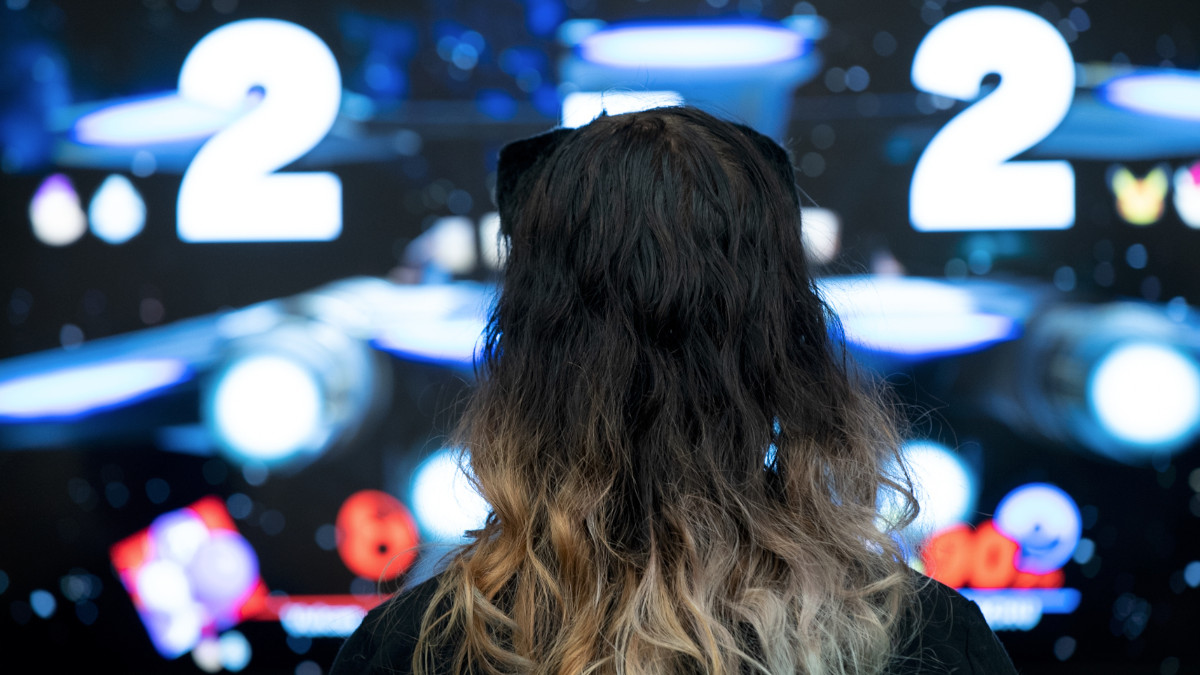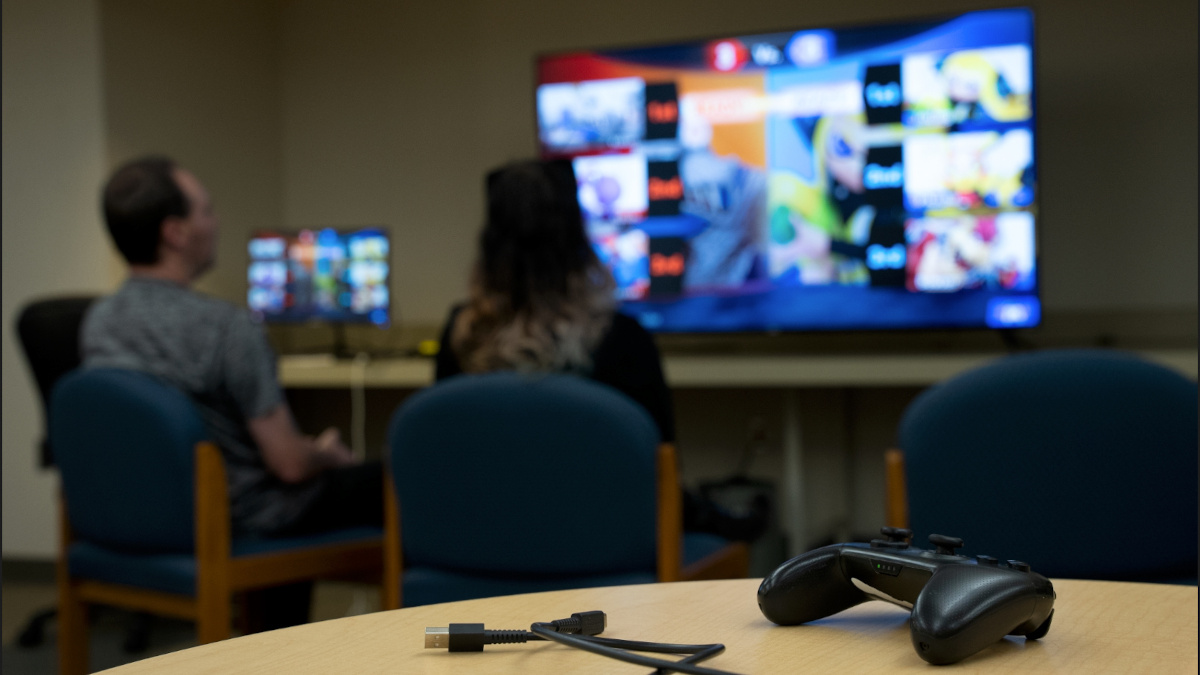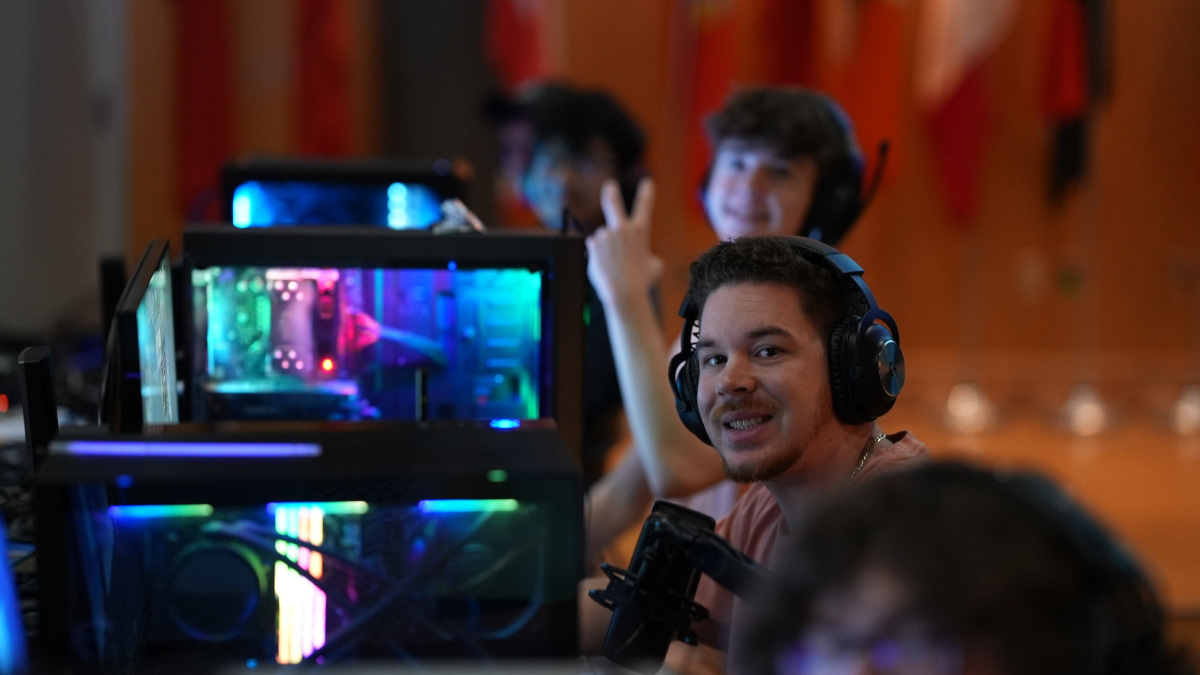Loading a New Game
Vandal Esports
Super Smash Bros. Ultimate. Valorant. Rocket League. Counter-Strike: Global Offensive. University of Idaho Esports athletes have joined NACE Starleague and they're building the team while competing in the Big Sky league.
U of I Taps Into Exploding Esports Industry to Give Students Community, Job Skills
Sonic the Hedgehog socks poke out from Colten Bernal’s sneakers. He says he didn’t wear them specifically for tonight, but perhaps they’ll bring him luck.
It turns out they don’t, at least during a practice match against his teammate. His character, Cloud, is ousted from the virtual platform by his opponent.
“Ahhh, but I was playing so well!” grieves the sophomore, in response to teammates’ ribbing as he preps for the next round of Nintendo’s Super Smash Bros. Ultimate, a fighting video game.
Although it’s only their first year playing together, the team is finding its groove.
“We are to the point that we are scouting the opponent to come up with a strategy for who would make the best matchups,” said Wayne Ebenroth, a senior. “We’ve shifted from ‘How do we do this?’ to ‘How do we win?’”
In Fall 2021, U of I fledged its first competitive esports team where multiple players square off in video games in front of an audience. Esports programs at universities with established teams can include scholarships for esports athletes, arenas for play and support teams including coaches, IT experts and data analysts. In the coming years, U of I plans to build its program, expanding the number of players, the games in which they compete and their support network.
We’ve shifted from ‘How do we do this?’ to ‘How do we win?’ Wayne Ebenroth, senior student
“Gaming is a valuable part of our society right now,” said Dan Ewart, vice president of information technology and chief information officer, who is championing the program at U of I. “It can open up opportunities for social interaction, employment opportunities, further education and just improve your happiness. Students enjoy this activity, and they enjoy doing it together.”
Intro Music Starts
Ewart has supported the team’s formation since he first heard the pitch for the squad from students.
“This is a big part of the culture of the students who want to attend U of I,” Ewart said. “As with anything else, we want to support their activities. They are the ones driving the creation, growth and direction of the program.”
The team is a step up from the Vandal Esports Club, which had a rocky start after it launched in Fall 2018. It struggled to gain visibility during the coronavirus pandemic, said club advisor Max Stillwell, application administrator with the Office of Information Technology.
“It’s a casual and competitive club. We want to make sure everyone feels included,” Stillwell said.
U of I’s esports team entered the field playing in the Electronic Gaming Federation (EGF) league — the league to which all Big Sky schools belong.
Universities in the EGF participate in tournaments — equivalent to a regular sports season — in which a school team competes at one video game. In their first year, U of I’s team played a tournament for Valorant, a multi-player first-person shooter game; they played roughly a dozen games against other schools and participated in the Valorant finals.
A university can join the EGF for free, but once a team becomes established, it pays an entrance fee, up to $10,000 depending on the number of tournaments entered; a fee U of I is expected to pay Fall 2023. Schools paid into EGF tournaments share revenue with the EGF, which makes money through Twitch stream advertising.
[Students] are the ones driving the creation, growth and direction of the program. Dan Ewart, vice president of information technology
For some, the new level of completive play is a motivating challenge.
“On an individual level, when you lose, you’re like, ‘Man, I'm so frustrated,’ but you just want to go back and prove that you’re just that much better the next time. Then you and your teammates can celebrate when you win,” said Deyondre Davis, a member of Rocket League — a video game where rocket-powered cars compete in soccer. “We’re just so close to a huge breakthrough where we’re going to be able to compete with absolutely anybody.”

Just Another Team Sport
In the 2022-23 school year, esports students branched out and formed teams for Smash Bros., Rocket League and Counter-Strike: Global Offensive, another multi-player first-person shooter game. They also joined the National Association of Collegiate Esports, called by its acronym NACE Starleague.
For the captain of the Smash Bros., starting the team was about seeing people face-to-face.
“Over COVID, I realized I am actually a people person. The online gaming community has its purposes, but I am more of an in-person player,” said Ebenroth, an accounting major. “Despite our team only being a few months old, we already started bonding.”
The players say their esports team is just like any other team, if a bit nontraditional.
“It goes beyond just playing the games,” said Davis, a criminology major in his junior year. “You become best friends while you’re playing something you enjoy. When you join the esports team, you grow your friend groups and diversify yourself within the University of Idaho community.”
In addition to gaining friends, esports can be very inclusive, Stillwell said, starting with the fact that teams are co-ed. Specialty controllers and accessibility customizations for games also allow people with disabilities to play competitively.
You become best friends while you’re playing something you enjoy. Deyondre Davis, junior student
“Esports is an ultimate representation of accessibility. People can play regardless of gender, physical abilities, sexual orientation, race, anything,” Ewart said.
While U of I’s club is not yet this diverse, it has attracted online students. In time the esports teams will likely recruit from the club through tryouts.
“In my first year, I didn’t do any clubs, but I realized it’s healthy to get out of your dorm and meet people,” Bernal said. “Come play games with us!”
Mario Gets a Power-Up
The Mario who first ran onto screens in 1989 wouldn’t recognize today’s gaming world. These days, gaming industry revenue outpaces that of movies and music combined.
While players may be the heart of the community, they have support upstream and downstream. The North America Scholastic Esports Federation (NASEF) breaks the industry down into four categories of jobs.
The strategists, including data analysts and coaches, help players perform at their best, while organizers, like general managers and IT support, ensure games happen. Then there are the industries and content creators surrounding esports; this includes software developers and artists. On a variety of streaming platforms, there are even game-day announcers, called shoutcasters, who commentate play, and post-game analysts who stream their reactions. Finally, there are entrepreneurs who rely on the industry, like marketers and corporate sponsors.
These potential jobs create an opening for U of I classes and clubs to engage with the esports teams.
Professor Barrie Robison is interested in having students in the Polymorphic Games (PG) class, where undergraduates develop video games, work with the esports program. The PG students, who range from computer science to art and business majors, work on designing, developing and marketing their own video games — all skills needed to support the esports program.
“I see some fun opportunities for real career training, ranging from analytics and broadcasting all the way to hardcore data science and developing new computer algorithms to analyze matches,” Robison said.
Faculty in movement sciences, psychology and engineering have all expressed interest in incorporating different dynamics of esports into their classrooms.

Supporting the Team
In Fall 2022, the team gained a new home, a gaming lab in the basement of the Bruce M. Pitman Center. The lab is free for students to use, although some machines will be reserved for the team at certain times for practice or tournaments. Renovations will continue as funds allow; they hope to install enough gaming consoles to conduct scrimmages — the first six will be installed in Spring 2023.
Having the new center should help the team, said Ebenroth, who took it upon himself to set up a minifridge in the gaming lab. It is a place to come together, he said, and provides machines for those who may not have their own. The new machines will attain the speed and graphics necessary to compete at the collegiate level.
In time, they hope to create a full gaming arena — a theater with a stage where the players sit with their consoles. They are also in the middle of building a shoutcaster studio.
The Department of Student Involvement and Recreation and Wellbeing stepped into help, providing three work study positions for students — two coaches and a manager position. Ewart said there’s an opportunity to support esports students with scholarships.
“The scholarships would help students commit to more than playing for fun with the club. It can be hard with their schedules — between working and classes — to prioritize the team,” Stillwell said.
Currently, regional teams like University of Montana and Boise State University offer scholarship opportunities to team members. Carson Cummins, a sophomore business major from Twin Falls, was recruited on a scholarship to play at Culver-Stockton College in Missouri before transferring to U of I.
“The scholarships give you the feeling that you’re actually competing for the university, which is a better feeling than just playing for your club,” said Cummins, who plays on the Rocket League team.
Ewart said U of I recruiters continually field questions from people asking about a university esports team.
“Competitions are streamed internationally, and people see the U of I logo,” he said. “It’s a new mechanism that many of us haven’t considered for getting the word out about our institution.”
For Ewart, supporting esports gives students another reason to become a Vandal and complete their degree at the university.
“If people have a community, they’re not just more likely to come here but stay,” he said. “And they'll see that there are many ways to make careers out of their love of gaming.”

Article by Leigh Cooper, University Communications and Marketing.
Video and photos by Garrett Britton, University Visual Production.
Published in April 2023.









